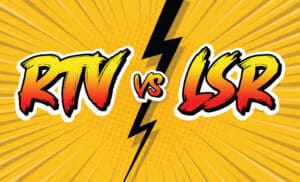![]() In the production of silicone rubber molding components, adding a protective coating at the end of the process will ensure the ruggedness and longevity of the product. Our proprietary coatings on silicone molded products protect against abrasion, harsh elements and provide superior protection against most chemicals. Advances in spray gun technology and fluid dynamics has led to extremely high quality, reliable options when choosing the proper equipment for coating silicone rubber.
In the production of silicone rubber molding components, adding a protective coating at the end of the process will ensure the ruggedness and longevity of the product. Our proprietary coatings on silicone molded products protect against abrasion, harsh elements and provide superior protection against most chemicals. Advances in spray gun technology and fluid dynamics has led to extremely high quality, reliable options when choosing the proper equipment for coating silicone rubber.
All spray guns atomize the fluid at the tip where the coating leaves the fluid nozzle. There are two passages designed into all guns with one carrying the fluid and the other carrying pressurized air. Atomization is acquired from the vacuum formed by the air rushing past the fluid tip, drawing the coating into the air stream. Atomization is defined as the making of an aerosol, which is a colloid suspension of liquid droplets into a gas. The air that is mixed with the fluid is expelled from the nozzle as a mist. There are two ways that spray guns are fed fluid. The conventional style uses high pressure that creates a vacuum to feed the fluid up from underneath the gun, while gravity fed style feeds fluid from above the gun so pressure isn’t required.
The type of spray gun used is vital to provide the most reliable coverage and consistency on silicone rubber products. A conventional spray gun can suffer from poor transfer efficiency. Transfer efficiency is defined as the percentage of coating material that exits the gun that actually ends up on the surface of the part being sprayed. The reasoning behind the poor transfer is the high pressures needed (50-60psi) to operate the gun. In using a conventional spray gun, approximately 1/3 of the coating will end up on the surface being coated. This results in significant material lost and a higher cost of production.
A high velocity lower pressure (HVLP) spray gun is similar to a conventional air powered spray gun, except it operates at a lower pressure. A higher volume of air is used to aerosolize and propel the spray at a lower pressure (20-30psi). Because of the lower pressures involved, HVLP guns are traditionally gravity fed. The pressure needed to create a vacuum to pull the fluid up from underneath in conventional feed guns is higher than the pressures used to operate an HVLP gun. The result of using a high quality HVLP gun translates into a much larger proportion of the spray coating the part. In turn, overspray is drastically reduced, so material consumption is decreased without reduction in total coverage, lowering the total production cost. In addition, HVLP guns give the operator greater control and precision for accurate and even coverage.
![]() At SiTECH, we offer a number of choices in coatings to enhance your silicone rubber products. All of our coatings are silicone based, which provides a homogeneous cross-link for a permanent bond. Si Coat I™ is a silicone-based coating that provides abrasion resistance for a long reliable work life. It also provides a clean matte finish to enhance the appearance of your silicone component. Si Coat II™ provides the same protection as Si Coat I™ with an added layer of protection to repel petrol-based chemicals. We use the highest quality HVLP spray guns available to coat all of our silicone rubber keypads. With the proper knowledge and equipment, SiTECH offers the highest quality silicone rubber components at competitive prices.
At SiTECH, we offer a number of choices in coatings to enhance your silicone rubber products. All of our coatings are silicone based, which provides a homogeneous cross-link for a permanent bond. Si Coat I™ is a silicone-based coating that provides abrasion resistance for a long reliable work life. It also provides a clean matte finish to enhance the appearance of your silicone component. Si Coat II™ provides the same protection as Si Coat I™ with an added layer of protection to repel petrol-based chemicals. We use the highest quality HVLP spray guns available to coat all of our silicone rubber keypads. With the proper knowledge and equipment, SiTECH offers the highest quality silicone rubber components at competitive prices.








